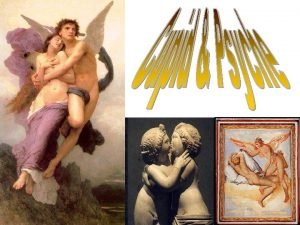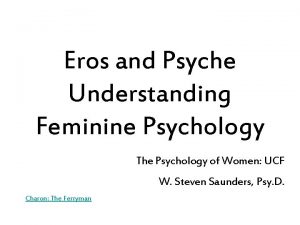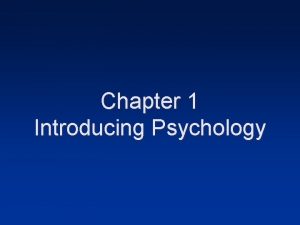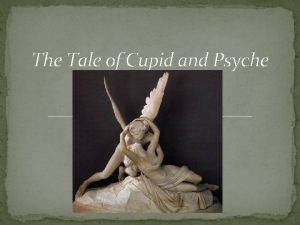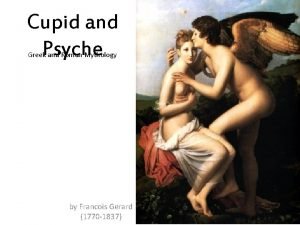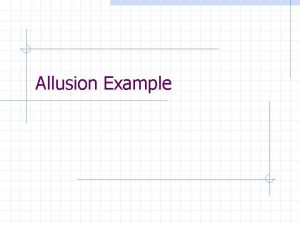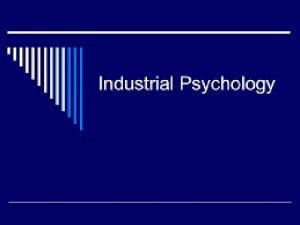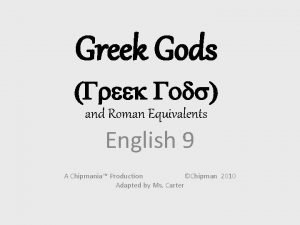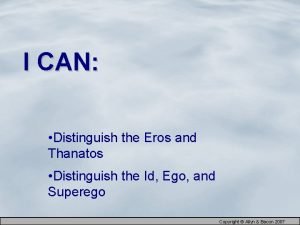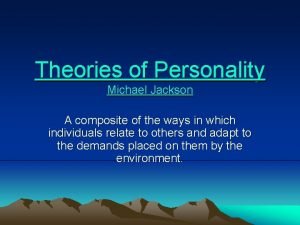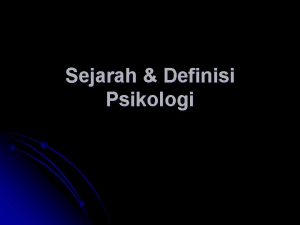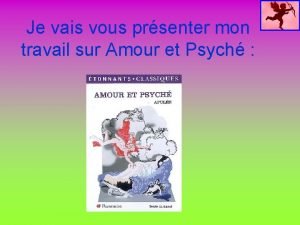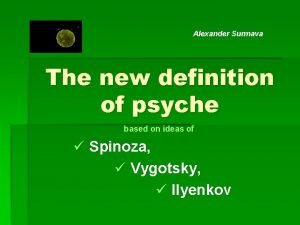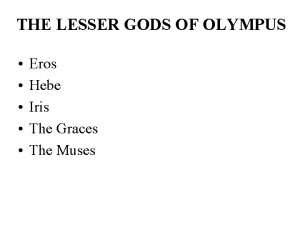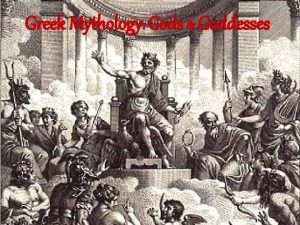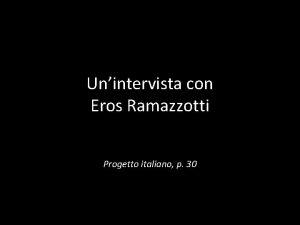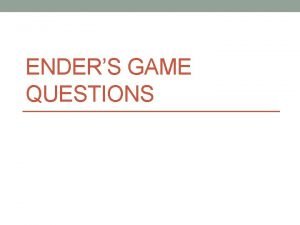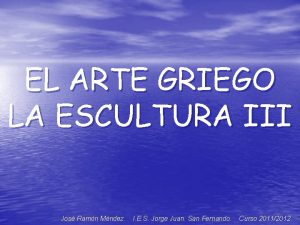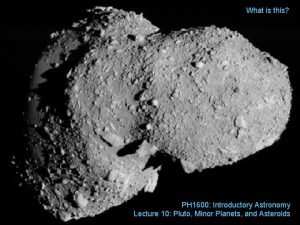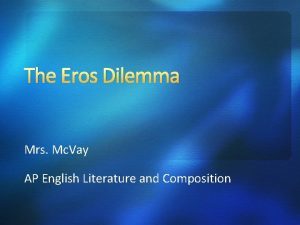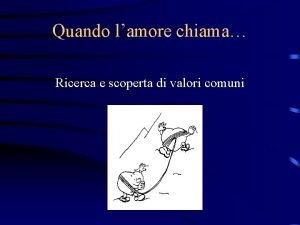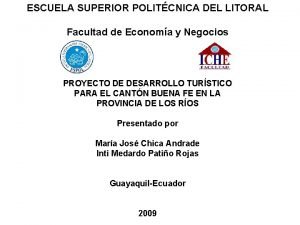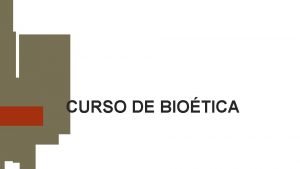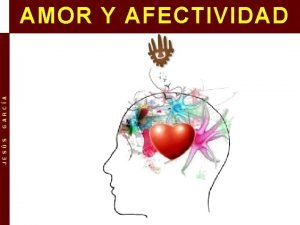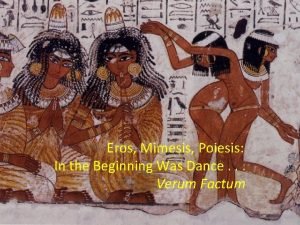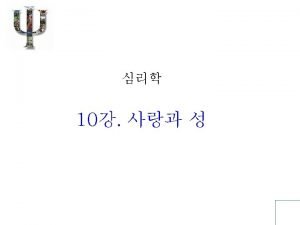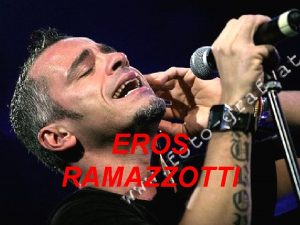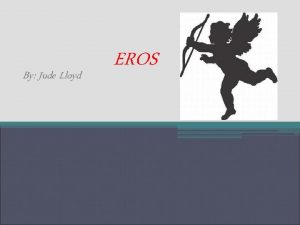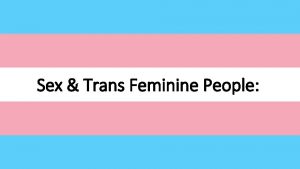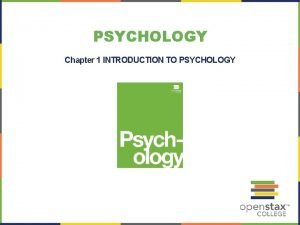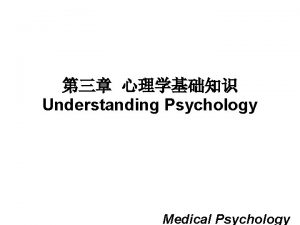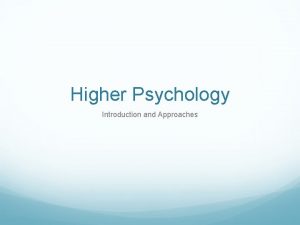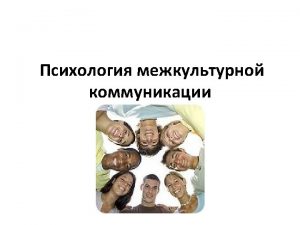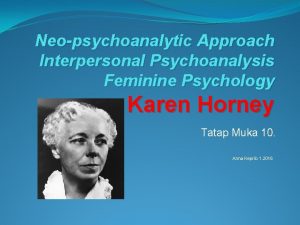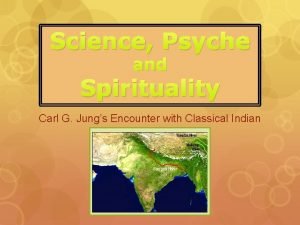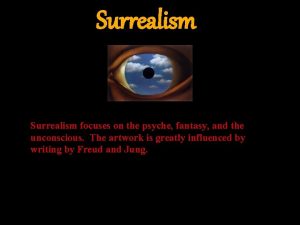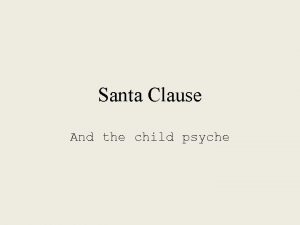Eros and Psyche Understanding Feminine Psychology The Psychology




































- Slides: 36

Eros and Psyche Understanding Feminine Psychology The Psychology of Women: UCF W. Steven Saunders, Psy. D. Charon: The Ferryman

• The Valley Spirit never dies: It is named the Mysterious Female. And the doorway to the Mysterious Female Is the base from which Heaven and Earth spring It is there within us all the while; Draw upon it, as you will. It never runs dry. • Tao Te Ching • We all have a feminine part and a masculine part, both Yin and Yang. Whereas the masculine part helps us to control things, analyze things, and make things happen in the world, the feminine part is our guide to and the connection with, our Soul. We need ways to resonate with our feminine side in order to have direction, meaning and purpose, and to fulfill our mission in life. • Lilian Borges Zeig

1. Yin and Yang – The Universal Life Forces. According to ancient Chinese knowledge and wisdom, there are two basic, complementary universal energies constantly in interaction with each other, always in movement, continuously creating change. They are in apparent opposition, e. g. : sun/moon; day/night; north/south, feminine/masculine; dark/bright, receptive/creative, and so on. These polar opposites, however, are human constructs only. In essence, these forces are not rigidly separated, static, they are fluid, they are in relationship, and they configure the unity of opposites. They function synergistically and in harmony, within a continuum where there are many gradations, according to the laws of Nature, to create balanced movement, harmony, and perpetual change through cyclical processes. Each energy contains elements of the other, as portrayed in the Yin/Yang symbol. Together they form the ultimate wholeness of our Universe, the Tao. The ancient Chinese constructed this evidence-based theory by careful, painstaking, centuries’ long observation and measurement of the pathways of the Sun around the Earth, the solstices, the equinoxes, and other celestial phenomena.

2. Yang is traditionally thought of as “masculine energy” – such as sun, fire, and light, bright, with active, creative, audacious, and aggressive qualities. Yin is thought of as “feminine energy”: moon, water, womb-like darkness, moist, earthiness, softness, with passive, receptive, and intuitive qualities. Throughout the 5, 000 -year history of our Western world, the Feminine Life Force has been systematically ignored, undervalued, repressed, misunderstood, particularly in human relations, thus engendering imbalance and disequilibrium at several levels. Resonating with the Feminine proposes to restore that balance by utilizing Ericksonian strategies. 3. In Jungian psychology it is proposed that these energies manifest in the human psyche as the anima (soul, eros) and the animus (spirit, logos). Anima (“the woman within”) is said to be the unconscious, feminine element of a man’s psyche, whereas the animus (“the man within”) is the unconscious, masculine element of a woman’s. Both are also believed to be mediators or bridges between the ego and the creative resources of the unconscious. Essentially, both males and females are androgynous psychologically, containing psychic energies from both -- as the yin/yang symbol demonstrates, and as Carl Jung and his followers proposed. Our psychological task is to bring into full consciousness those energies, developing, refining, and integrating the qualities, attributes, characteristics and properties hitherto unacknowledged, discounted, undervalued, disowned or repressed.

4. Evolution of consciousness: According to Jung both the anima and the animus undergo four stages of evolution in consciousness. In women, the animus (the man within) first emerges as a representation of physical power, physical endurance. In the next stage it surfaces as possessing audacity, initiative, and enterprise. A third phase involves the sophisticated use of “the word” represented by professors, politicians, clergymen. In the fourth stage it becomes “the incarnation of meaning” through attainment of higher spiritual consciousness and wisdom. Purpose and meaning triumph and prosper. 5. Resonating with the Feminine implies then becoming aware of the subtle energies of the Feminine Principle – the life-giving force -- which will engender psychological well being, balance, and harmonious relations with humans and nature. Qualities such as patience, persistence, perseverance, gentle persuasion, tolerance, fairness, sense of equality, freedom of thought, freedom of being, sense of justice, non-violence, inclusiveness, unconditional love, intuition and acting from the wisdom of an inner core all Feminine Qualities. In concrete terms, for the anima in men, positive means to uncover, discover or contact subtle energies (which engender those qualities), could be through painting, music, sculpture, writing, dancing, baking, cooking, intensive or extensive contact with nature through protection and stewardship of the environment, care and nurturing of children.

1. For the animus in women, constant awareness, and constant questioning her own positions and beliefs, mastering the unacknowledged talents, characteristics, virtues and qualities (such as decisiveness, entrepreneurship, initiative, audacity, boldness, courage) these are the tasks too. Her “male within” then, will be a source of equilibrium, inner companionship, solace, and attainment of higher spiritual wisdom (symbolized by Sophia, Wisdom or Sapientiae).

Why is Eros sent to Psyche?

What myth or fairy tale has similar elements? What is Psyche’s vow and why does she break it?

What botches it all and why does Eros flee? What’s Aphrodite’s response?

The Wanderings • Pan keeps Psyche from killing herself. • Psyche sets out in search of Eros. • Aphrodite learns from a seagull that Psyche is about. • Aphrodite recruits Mercury (Hermes) to round up Psyche, and she abuses Psyche.

The Four Tasks • Aphrodite sets Psyche a series of tasks meant to kill her, but Psyche comes across a series of helpers: – Sort grain – ants. – Obtain fleece from the sheep of the sun – reed. – Obtain water from Stygian stream – eagle. – Bring back beauty from Persophne – Tower, Eros.

Charon: The Ferryman

The Happy End • Eros’s wound is now healed. After rescuing Psyche, he takes the box from Persophne to his mother. • Eros pleads for Psyche to Zeus, who says, “Let him take her and possess her. Let him hold her in his arms and never depart from the delight of that embrace. ” • Zeus reassures Aphrodite and makes Psyche immortal.

Now, the bigger questions… • What do we learn about Greek gods in this story? • What other myths are mentioned in this one (or are parallel)? • Why does this story exist? What do we learn?

Notes for Further Analysis: “Eros and Psyche” • Jungian analysis works well on this story, with Aphrodite as Psyche’s shadow. Agree? • Levi-Straussian analysis can be interesting as well. Psyche moves from nature to culture (the realm of the gods, death) and to a more balanced point when Eros finally recovers enough to help her.

Psyche and Eros in Modern Times How the Myth continues to inform us today…




Jung’s Landscape Psyche refers to the totality of all psychological processes. It “embraces all thought, feeling, and behavior, both conscious and unconscious. It functions as a guide which regulates and adapts the individual to his social and physical environment. ” “My psychology isn’t worth anything if it can’t be understood by a Swiss farmer!” Yikes!


The Self Ø The Center of the Psyche Ø The “Central Archetype” Ø Like the Sun in the Center of the Solar System Ø Archetype of order, organization, and unification Ø Unites the personality Ø Responsible for fulfilling the blueprint of life Ø At birth – all is the Self Ø Connecting bridge to “The Unity” Ø Goal is psychological wholeness and completeness Ø Transpersonal, transcends the ego

Archetypes Ø Primordial structural elements of the psyche Ø Functional units of the collective unconscious (later called “The Objective Psyche”) Ø Archetype = “First, ” “Original, ” “Prototype” Ø Primordial Images Ø Blueprint for Life (like an innate releasing mechanism in certain animals) Ø Universal Ø Unconscious Ø Collective unconscious is distinct from the Personal Unconscious

Complexes Ø Emotionally charged group of ideas or images ØFunctional units of the personal unconscious Ø A group of associated “feeling-toned ideas” bound together by a shared emotional charge Ø Unconscious, highly emotional, feel autonomous Ø Like split-off, partial, independent, and separate personalities Ø Vital part of everyone’s psychological make-up Ø The less conscious, the greater its degree of autonomy, and the more we will project it onto others.

The Ego Ø The central complex in the field of consciousness Ø Organizing function of the conscious mind Ø Gives sense of identity, continuity and personality – “I” Ø Composed of conscious perceptions, memories, thoughts and feelings Ø The “gatekeeper to consciousness” Ø Actually a very small part of the overall psyche

The Persona The part of ourselves we show to the world. Personae from the Latin for “Mask. ” Helps us adapt to society – to conform to the roles we play in our relationships and culture. Social masks allow conversation and commerce to flow easily from one person to another. Sometimes our “New Year’s Resolution self. ”

The Shadow All that is set aside, repressed, or unrecognized. Hidden part of ourselves that has been repressed or never recognized. All that is banished from the persona. Unconscious and unknown part of ourselves. All that we think we are not. Our unlived life. There is gold in the shadow. Accepting the shadow means accepting our full humanity.

Illuminating the Shadow 1. Make a list of all the adjectives that you (or someone who knows you well) would use to describe you. Take the opposite of that word and write it down. That list comprises some of what is in your shadow. 2. Look honestly at those you immediately dislike or like. What is it about them that is similar or different to how you see yourself? 3. Ask someone who knows you well one simple question: “What is my greatest flaw? ” 4. Look at the content of dreams and slips of the tongue.

Anima/Animus: The Internal Masculine and Feminine Anima – The internal, unconscious feminine aspect of a man Animus – The internal, unconscious masculine aspect of a woman Jung speaks of the anima/animus as both archetypes and complexes. They are: 1) unconscious 2) charged with emotion 3) relatively autonomous.

Relationship Between Anima/Animus and the Ego

Yin Yang Feminine Masculine Negative Positive Moon Sun Darkness Light Yielding Aggressive Left side Right side Warm Cold Autumn Spring Winter Summer Unconscious Conscious Emotion Reason Right Brain Left Brain

What is unconscious will be projected onto others and into the world. Wholeness requires withholding projections and bringing what is unconscious into consciousness.

Holding the Tension of the Opposites by Integrating Dualities The Transcendent Function: The psychic function that arises from the tension and conflict between consciousness and the unconscious. Thesis Antithesis Synthesis

Relative Proportions: Conscious and Unconscious

What Does It Mean to be Conscious? Ø From the Latin conscius, meaning “knowing with others, participating in knowledge, or aware of. ” Ø Includes all the things we are aware of and know Ø An understanding of “knowing that we know” Ø Sometimes builds slowly and sometimes comes like a blinding insight Ø Awakening Ø A dynamic process of growth, change, and evolution Ø Consciousness best defined on a spectrum or continuum rather than “all or none”

Consciousness is best thought of as manifesting in steps, layers, dimensions, sheaths, levels or grades -- holarchy Vijnanas -- Buddhism Koshas - Vedanta Layers of consciousness -Jung Sefiroth Kabbalah Spectrum of Consciousness – Western philosophers (e. g. , Ken Wilber)
 Cupid and psyche
Cupid and psyche Psyche et eros
Psyche et eros What is psychology
What is psychology Cupid and psyche background
Cupid and psyche background Cupid and psyche introduction
Cupid and psyche introduction Cupid and psyche allusions
Cupid and psyche allusions Psyche and logos
Psyche and logos Eros symbols and meanings
Eros symbols and meanings Eros thanatos id ego superego
Eros thanatos id ego superego Michael jackson personality
Michael jackson personality Carl jung anima and animus
Carl jung anima and animus Maurice denis the story of psyche
Maurice denis the story of psyche Pure shift nmr
Pure shift nmr Kata psikologi berasal dari
Kata psikologi berasal dari Amour et psyché apulée résumé
Amour et psyché apulée résumé Psyché définition
Psyché définition Psyche in cancer
Psyche in cancer The graces olympus
The graces olympus Greek gods family tree
Greek gods family tree Eros ramazzotti intervista
Eros ramazzotti intervista Eros ender's game
Eros ender's game Eros de tespias
Eros de tespias What is this
What is this Eros worms
Eros worms Mrs eros
Mrs eros Eros ludus storge pragma mania agape
Eros ludus storge pragma mania agape Cascada 4 eros
Cascada 4 eros Eros nerry
Eros nerry Eros ecotica
Eros ecotica Eros call center
Eros call center Shrek psychoanalysis
Shrek psychoanalysis Eros agape
Eros agape Mimesis poiesis
Mimesis poiesis John lee love
John lee love Eros y psique escultura
Eros y psique escultura Eros y psique
Eros y psique National 5 psychology
National 5 psychology
